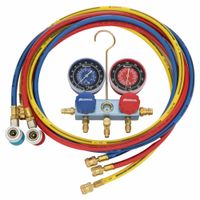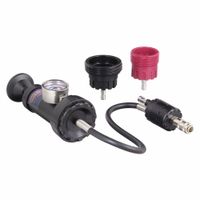Call +(254) 703 030 000 / 751 483 999 / 721 704 777
- Home
- Fleet Vehicle Maintenance
- Vehicle Tools
- Vehicle Diagnostic Tools
- Vehicle Heating Cooling Diagnostic Tools
Vehicle Heating & Cooling Diagnostic Tools
Servicing vehicle heating and cooling systems requires specialized diagnostic tools and equipment. A/C diagnostic tools identify problems in automotive air conditioning systems. Radiator and cooling system diagnostic tools test pressure and identify leaks in these automotive systems. Read Less
Frequently Asked Questions
What are the common signs of a failing vehicle heating system?
Common signs of a failing vehicle heating system include:
1. **Insufficient Heat**: The most obvious sign is when the heater blows cold or lukewarm air instead of hot air, indicating a problem with the heater core, thermostat, or coolant levels.
2. **Coolant Leaks**: Puddles of coolant under the vehicle or a sweet smell inside the cabin can indicate a leak, often from the heater core or hoses.
3. **Foggy Windows**: If the defroster is not working properly, windows may fog up and not clear, suggesting a malfunction in the heating system.
4. **Unusual Noises**: Grinding, squealing, or other unusual noises when the heater is on can indicate a problem with the blower motor or fan.
5. **Temperature Fluctuations**: Inconsistent cabin temperatures or fluctuating heat levels can be a sign of a failing thermostat or air pockets in the cooling system.
6. **Overheating Engine**: A malfunctioning heating system can cause the engine to overheat if the coolant is not circulating properly.
7. **Burning Smell**: A burning odor when the heater is on can indicate electrical issues or debris in the heating system.
8. **Dashboard Warning Lights**: The appearance of warning lights related to the engine or temperature can signal issues with the heating system.
9. **Reduced Airflow**: Weak airflow from the vents, even when the fan is on high, can indicate a clogged cabin air filter or issues with the blower motor.
10. **Visible Steam**: Steam coming from the vents can indicate a leaking heater core.
Addressing these signs promptly can prevent further damage and ensure the vehicle's heating system functions properly.
How do I know if my car's A/C system needs servicing?
1. **Weak Airflow**: If the airflow from the vents is weaker than usual, it may indicate a clogged filter, blower motor issue, or duct blockage.
2. **Warm Air**: If the A/C blows warm air instead of cold, it could be due to low refrigerant levels, a faulty compressor, or a malfunctioning condenser.
3. **Unusual Noises**: Grinding, squealing, or rattling noises when the A/C is on can signal issues with the compressor or fan.
4. **Foul Odors**: Musty or moldy smells from the vents may suggest mold growth in the evaporator case or a dirty cabin air filter.
5. **Water Leaks**: Puddles of water inside the car, especially on the passenger side, can indicate a clogged drain hose or evaporator case.
6. **Frequent Cycling**: If the A/C turns on and off frequently, it might be due to an electrical issue or a failing compressor.
7. **Visible Refrigerant Leaks**: Oily spots under the car or around A/C components can indicate refrigerant leaks.
8. **Dashboard Warning Lights**: Some cars have A/C-specific warning lights that illuminate when there's a problem.
9. **Inconsistent Cooling**: If the temperature fluctuates or takes too long to cool, it might be due to a failing thermostat or sensor issues.
10. **High Humidity Inside**: If the A/C fails to remove humidity effectively, it could be due to a malfunctioning evaporator or low refrigerant.
11. **Increased Fuel Consumption**: A struggling A/C system can cause the engine to work harder, leading to higher fuel consumption.
12. **Age of the System**: Older systems may require more frequent servicing due to wear and tear.
What tools are needed to diagnose A/C problems in a car?
Manifold gauge set, refrigerant leak detector, digital multimeter, infrared thermometer, vacuum pump, refrigerant recovery machine, UV dye and UV light, electronic refrigerant scale, and a scan tool or OBD-II scanner.
How can I test for leaks in my car's radiator?
1. **Visual Inspection**: Check for visible signs of coolant leaks around the radiator, hoses, and connections. Look for puddles or stains under the car.
2. **Pressure Test**: Use a radiator pressure tester to pressurize the cooling system. Attach the tester to the radiator cap opening and pump it to the recommended pressure. Observe the gauge for pressure drops, indicating a leak.
3. **Check Coolant Level**: Ensure the engine is cool, then remove the radiator cap and check the coolant level. A consistently low level may indicate a leak.
4. **Dye Test**: Add a UV-reactive dye to the coolant system. Run the engine to circulate the dye, then use a UV light to inspect for glowing areas indicating leaks.
5. **Inspect Hoses and Clamps**: Examine radiator hoses and clamps for cracks, wear, or loose connections. Tighten or replace as necessary.
6. **Radiator Cap Test**: Test the radiator cap using a cap tester to ensure it maintains the correct pressure. A faulty cap can cause leaks.
7. **Check for Steam**: With the engine running, look for steam escaping from the radiator or hoses, which can indicate a leak.
8. **Listen for Hissing**: Listen for hissing sounds when the engine is running, which may indicate escaping steam or coolant.
9. **Examine the Overflow Tank**: Check the overflow tank for cracks or leaks and ensure the hose connecting it to the radiator is secure.
10. **Professional Inspection**: If unable to locate the leak, consult a professional mechanic for a thorough inspection.
What is the cost of servicing a vehicle's cooling system?
The cost of servicing a vehicle's cooling system can vary widely depending on several factors, including the type of vehicle, the specific services required, and the location of the service provider. On average, a basic cooling system service, which typically includes a coolant flush and refill, can range from $100 to $150. This service involves draining the old coolant, flushing the system to remove any debris or contaminants, and refilling it with new coolant.
If additional repairs or replacements are needed, such as fixing leaks, replacing hoses, or installing a new radiator, the costs can increase significantly. For instance, replacing a radiator can cost between $300 and $900, depending on the vehicle make and model. Replacing hoses might add another $50 to $150 to the total cost.
Labor costs also play a significant role in the overall expense. Mechanics typically charge between $70 and $100 per hour, and more complex repairs can take several hours to complete. Additionally, the cost of parts can vary based on whether OEM (Original Equipment Manufacturer) or aftermarket parts are used.
Geographical location can also impact the cost, with services in urban areas generally being more expensive than in rural areas. It's advisable to get multiple quotes from different service providers to ensure a competitive price.
Regular maintenance of the cooling system is crucial to prevent overheating and potential engine damage, which can lead to more costly repairs. Therefore, while the upfront cost of servicing might seem high, it can save money in the long run by avoiding major engine repairs.
How often should I service my car's heating and cooling systems?
You should service your car's heating and cooling systems at least once a year. Regular maintenance ensures optimal performance and prevents potential issues. During this service, a technician will check the coolant levels, inspect hoses and belts for wear, and test the thermostat and heater core. They will also examine the air conditioning system, checking for refrigerant leaks, inspecting the compressor, and ensuring the condenser and evaporator are functioning properly.
In addition to the annual service, pay attention to any signs of trouble, such as unusual noises, reduced heating or cooling efficiency, or strange odors. If you notice any of these symptoms, have your systems checked immediately, regardless of the last service date.
For vehicles driven in extreme climates or under heavy usage, more frequent checks may be necessary. Always refer to your vehicle's owner manual for specific recommendations, as some manufacturers may have different guidelines based on the car model and year. Regular servicing not only extends the life of your heating and cooling systems but also enhances your comfort and safety on the road.
Can I service my car's A/C system myself, or do I need a professional?
You can service some basic aspects of your car's A/C system yourself, but for more complex tasks, a professional is recommended. DIY tasks include checking and replacing the cabin air filter, cleaning the A/C vents, and ensuring the system is free of debris. You can also recharge the refrigerant if you have the proper tools and follow safety guidelines, as refrigerant handling can be hazardous.
However, diagnosing and repairing issues like leaks, electrical problems, or compressor failures typically require specialized knowledge and equipment. Professionals have the expertise to safely handle refrigerants, identify underlying issues, and ensure the system is properly sealed and functioning efficiently. Additionally, improper handling of the A/C system can lead to further damage or void warranties.
In summary, while you can perform basic maintenance, complex repairs should be left to professionals to ensure safety and effectiveness.

